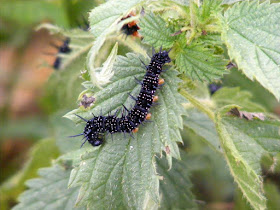Answer: Common Nettle Urtica dioica and sometimes Wild Hop Humulus lupulus.
So I'm talking about the abundant and widely distributed butterfly Aglais io, known as le Paon-du-jour (the Day Peacock) in French and the Peacock in English.
I love the little orange tootsies and the star spangled body.
Here in the Touraine it is nice to keep a little patch of nettles in an abandoned corner of your garden. You will most likely be rewarded for your slovenly gardening habits by a host of spiky black caterpillars diligently munching away sometime between May and September. These ones, of mixed ages, were photographed yesterday near our orchard.
The caterpillars in this nettle patch ranged considerably in size (and therefore age).
They will overwinter as chrysalises suspended from a nettle or a nearby plant, then once the weather warms up next year, probably in June, they will emerge. If you have a garden shed then their parents may hibernate in there and emerge even earlier in the year. Sunny days in February will see the adults out and about. Their ability to overwinter in different life stages and their diet of a common 'weed' contributes to their breeding rate (three generations a year usually) and their ubiquity in gardens throughout the year in all but the coldest gloomiest weather.
An adult Peacock butterfly.




5 comments:
Thanks for the interesting enlightenment Susan.
We have a lot of Peacocks...
but then again, our meadow is full of nettles and wild hops!!
Why doesn't anyone publish pictures of the equally wonderful underwings of the Peacock.... the patterning on those is wonderful.
I thought about putting in a photo of the underside but I wrote this yesterday in a hurry and was too lazy to go upstairs and use the other computer to find a photo of the underside in our database. The database is too big to run on my laptop.
As far as I can guess, the Grand Paon de Jour is called that way in French to oppose a moth, Saturnia Pyri, Great Peacock Moth, which is called Grand Paon de Nuit.
Yes I assumed the same.
Post a Comment